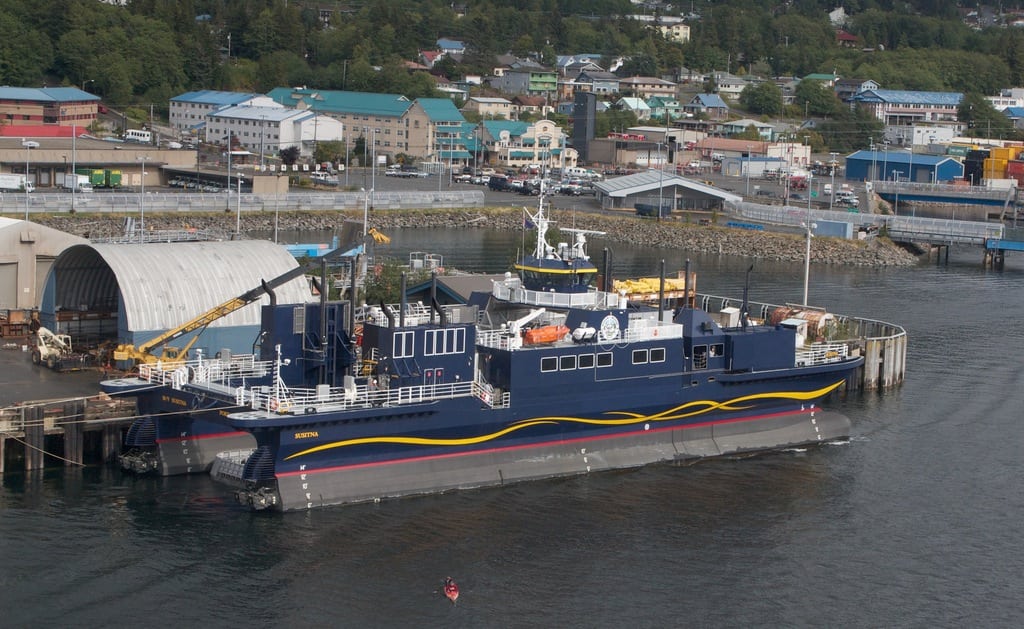Alaska's ferry to nowhere could land in the Netherlands or U.S. Virgin Islands

Skift Take
One $80 million ice-breaking ferry, one $751,000 bid to buy it.
The Matanuska-Sustina Borough, trying to rid itself of the novel ferry it once embraced but has never used, received just a single bid by the noon Friday deadline. It doesn't have to accept it.
The vessel was completed in 2011 and born out of a partnership between the borough, which wanted a ferry, and the Navy, which wanted a fast military landing craft. Named the Susitna, it was built as a Navy prototype that would be owned and operated by the borough. The project was funded mainly with Department of Defense earmarks wedged into the federal budget by then-U.S. Sen. Ted Stevens.
But the borough hasn't been able to get suitable docks or a workable business plan to operate it as a ferry between Anchorage and Port MacKenzie in the Mat-Su.
With monthly costs to the borough averaging $75,000 for insurance, maintenance, fuel, docking fees and other expenses, the Borough Assembly has directed employees to find the most economical way to shed it.
While the borough solicited buyers, it also launched a parallel track to give away the boat to a government organization that met federal requirements. Of those that expressed interest, proposals by Los Angeles County and the U.S. Virgin Islands are still being evaluated by the Federal Transit Administration.
Name your own price for ferry
On Friday, Russ Krafft, the borough purchasing officer, opened the sole bid, a $751,000 offer from Workships Contractors BV, based in The Netherlands. It wants to use the vessel to support offshore wind farms, according to the borough.
"I was expecting more offers and higher offers, even if it was just for scrapping the vessel," said Marc Van Dongen, the borough's port director.
Patty Sullivan, the borough's public affairs director, told him there was no need to talk about turning the highly engineered vessel -- with a barge deck that raises for faster sailing and lowers for beach landings -- into scrap. She's spent hours with the designers and ridden on it for test runs and appreciates its steady state at sea. It is docked near the Ketchikan shipyard where it was built.
The borough has engaged international ship brokers and queried the Alaska Marine Highway System about taking it on. The state ferry system, in a new draft study, concluded the Susitna would be expensive to run and that existing docks would need to be reconfigured. The study said the boat can hold 134 passengers but only 20 vehicles, and burns 375 gallons of fuel an hour. A state ferry with a similar capacity, the Lituya, burns 55 gallons an hour. The state ferry system doesn't want the Susitna, the staff report said.
Varied inquiries
The borough has checked with the Coast Guard, oil spill cleanup companies, and Royal Dutch Shell, one of the major companies trying to drill in the Alaska Arctic. It's heard from entrepreneurs, including a man who wanted to turn it into a floating casino off the coast of Hong Kong. That didn't seem right for a vessel that the Navy helped design and pay for, Sullivan said.
Emerson Krueger, a borough planner who is leading the search for a new ferry home, has heard from all sorts.
"The best so far as far as commercial interest in purchasing the vessel was a guy in Denmark who represents a group of Chinese investors that owned an offshore resort outside the coast of Singapore and wanted to buy the vessel for somewhere between $10 and $20 million and use it to run their guests," Krueger said.
But only Workships made an official bid and put up $5,000 in earnest money.
While most of the money to build the boat came from defense earmarks, the Federal Transit Administration invested at least $12 million into outfitting the boat, engineering and design work for ferry landings, and a ferry terminal. The borough also has $6 million from the transit agency still in hand. The agency expects at least a portion of the grants to be repaid unless the boat is put to use for public transit by a government entity.
The borough doesn't yet know how much it might owe the federal agency, but the $751,000 offer provides a sense of market interest, Krafft said. The best option will likely be to give the boat to another government agency, Van Dongen said.
The government of the Northern Mariana Islands, a U.S. territory, said it was interested, but then seemed to back off. A community college in Seattle inquired about acquiring it to train merchant marines, but that's not a public transit purpose. A fledgling research laboratory in Wisconsin wants it, too. A village of Native Hawaiians sent representatives in an executive jet to Alaska to check out the boat, but would have had to partner with the state, the federal agency told the borough. And that hasn't happened.
At least two governments are still on the list being considered by the Federal Transit Administration, the borough said.
Los Angeles County or U.S. Virgin Islands perhaps
Los Angeles County wants to use the Susitna for public ferry service to Catalina Island, and also as an emergency response vessel that could respond to oil spills, conduct search and rescue operations, transport equipment, and serve as a sea-based mobile command, county chief executive William Fujioka and fire chief Daryl Osby said in a Feb. 22 letter to the borough.
The U.S. Virgin Islands is "in dire need of reliable inter-island travel," Senate President Shawn-Michael Malone wrote in a March 18 letter to the borough. The ferry that used to run between St. Thomas and St. Croix was severely damaged in a 2011 accident at sea, he said.
Ultimately, the Borough Assembly will decide the Susitna's future.
Reach Lisa Demer at ldemer@adn.com or 257-4390. ___
![]()




